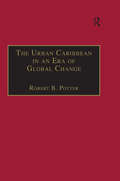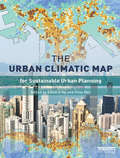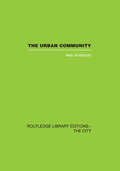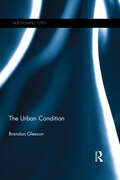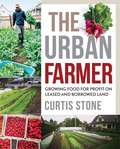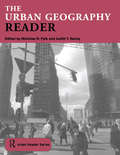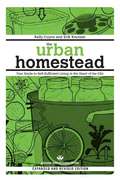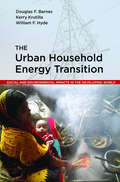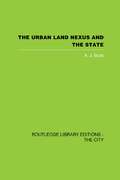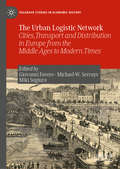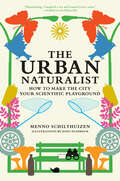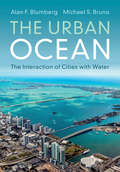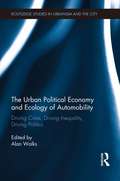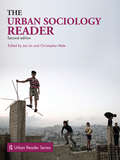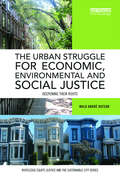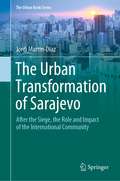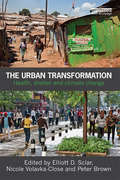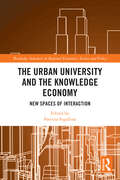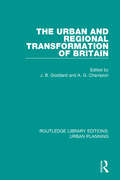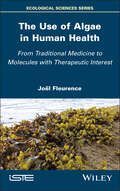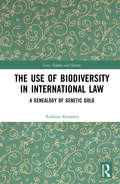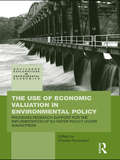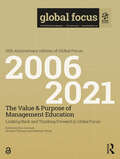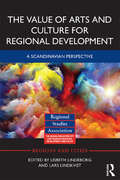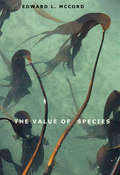- Table View
- List View
The Urban Caribbean in an Era of Global Change
by Robert B. PotterBased on the author’s first hand field research, this book addresses the twin processes of urbanization and globalization as they affect the contemporary Caribbean region. One of the key aims of the book is to focus attention on the fact that contrary to popular perceptions, the Caribbean is highly urbanized. Indeed statistics show that the region is more highly urbanized than the world taken as a whole. In addition, the fact that the Caribbean region has always been affected by processes of globalization, in respect of its economy, polity and society, is central to the text. The chapters cover pressing topics such as urban change and the evolution of mini-metropolitan regions, the importance of the mercantile and plantopolis frameworks, tourism, post modernity and the urban nexus, economic change and the dual processes of global convergence and divergence, and the nature of the relationships existing between the state, the informal sector, housing and environmental conditions. In reality, it is shown that the development of tourism and enclave manufacturing is leading to new forms of urban concentration, and not spatial dispersal.
The Urban Climatic Map: A Methodology for Sustainable Urban Planning
by Edward Ng Chao RenRapid urbanization, higher density and more compact cities have brought about a new science of urban climatology. An understanding of the mapping of this phenomenon is crucial for urban planners. The book brings together experts in the field of Urban Climatic Mapping to provide the state of the art understanding on how urban climatic knowledge can be made available and utilized by urban planners. The book contains the technology, methodology, and various focuses and approaches of urban climatic map making. It illustrates this understanding with examples and case studies from around the world, and it explains how urban climatic information can be analysed, interpreted and applied in urban planning. The book attempts to bridge the gap between the science of urban climatology and the practice of urban planning. It provides a useful one-stop reference for postgraduates, academics and urban climatologists wishing to better understand the needs for urban climatic knowledge in city planning; and urban planners and policy makers interested in applying the knowledge to design future sustainable cities and quality urban spaces.
The Urban Condition (Questioning Cities)
by Brendan GleesonThis book will speak to the new human epoch, the Urban Age. A majority of humanity now lives for the first time in cities. The city, the highest invention of the modern age, is now the human heartland. And yet the same process that brought us the city and its wonders, modernisation, has also thrown up challenges and threats, especially climate change, resource depletion, social division and economic insecurity. This book considers how these threats are encountered and countered in the urban age, focusing on the issue of human knowledge and self-awareness, just as Hannah Arendt’s influential The Human Condition did half a century ago. The Human Condition is now The Urban Condition. And it is this condition that will define human prospects in an age of default and risk. Gleeson expertly explores the concept through three main themes. The first is an exploration of what defines the current human condition, especially the expanding cities that are at the heart of an over-consumptive world economic order. The second exposes and reviews the reawakening of forms of knowledge (‘naturalism’) that are likely to worsen not improve our comprehension of the crisis. The new ‘science of urbanism’ in popular new literature exemplifies this dangerous trend. The third and last part of the book considers prospects for a new urban, and therefore human, dispensation, ‘The Good City’. We must first journey in our urban vessels through troubled times. But can we now start to plot the way to new shores, to a safer, more resilient city that provides for human flourishing? The Urban Condition attempts this ideal, conceiving a new urbanism based on the old idea of self-limitation. The Urban Condition is an original, timely book that reconsiders and redeploys Arendt’s famous notion of The Human Condition in an age of cities and risk. It brings together several important strands of human consideration, urbanisation, climate threat, resource depletion, economic default and critical knowledge and weaves them into a new analysis of the times. It also looks to a future that is nearly with us—of changed climate, resource scarcity and economic stress. The book journeys into these troubled times, proposing the idea of Lifeboat Cities as a way of thinking about the human journey to come
The Urban Farmer
by Curtis Allen StoneThere are twenty million acres of lawns in North America. In their current form, these unproductive expanses of grass represent a significant financial and environmental cost. However, viewed through a different lens, they can also be seen as a tremendous source of opportunity. Access to land is a major barrier for many people who want to enter the agricultural sector, and urban and suburban yards have huge potential for would-be farmers wanting to become part of this growing movement.The Urban Farmer is a comprehensive, hands-on, practical manual to help you learn the techniques and business strategies you need to make a good living growing high-yield, high-value crops right in your own backyard (or someone else's). Major benefits include: Low capital investment and overhead costs Reduced need for expensive infrastructure Easy access to marketsGrowing food in the city means that fresh crops may travel only a few blocks from field to table, making this innovative approach the next logical step in the local food movement. Based on a scalable, easily reproduced business model, The Urban Farmer is your complete guide to minimizing risk and maximizing profit by using intensive production in small leased or borrowed spaces.Curtis Stone is the owner/operator of Green City Acres, a commercial urban farm growing vegetables for farmers markets, restaurants, and retail outlets. During his slower months, Curtis works as a public speaker, teacher, and consultant, sharing his story to inspire a new generation of farmers.
The Urban Geography Reader (Routledge Urban Reader Series)
by Judith T. Kenny Nicholas R. FyfeDrawing on a rich diversity of theoretical approaches and analytical strategies, urban geographers have been at the forefront of understanding the global and local processes shaping cities, and of making sense of the urban experiences of a wide variety of social groups. Through their links with those working in the fields of urban policy design, urban geographers have also played an important role in the analysis of the economic and social problems confronting cities. Capturing the diversity of scholarship in the field of urban geography, this reader presents a stimulating selection of articles and excerpts by leading figures. Organized around seven themes, it addresses the changing economic, social, cultural, and technological conditions of contemporary urbanization and the range of personal and public responses. It reflects the academic importance of urban geography in terms of both its theoretical and empirical analysis as well as its applied policy relevance, and features extensive editorial input in the form of general, section and individual extract introductions. Bringing together in one volume 'classic' and contemporary pieces of urban geography, studies undertaken in the developed and developing worlds, and examples of theoretical and applied research, it provides in a convenient, student-friendly format, an unparalleled resource for those studying the complex geographies of urban areas.
The Urban Homestead (Expanded & Revised Edition)
by Kelly Coyne Erik KnutzenThe expanded, updated version of the best-selling classic, with a dozen new projects."A delightfully readable and very useful guide to front- and back-yard vegetable gardening, food foraging, food preserving, chicken keeping, and other useful skills for anyone interested in taking a more active role in growing and preparing the food they eat."-BoingBoing.net"...the contemporary bible on the subject."-The New York TimesThis celebrated, essential handbook shows how to grow and preserve your own food, clean your house without toxins, raise chickens, gain energy independence, and more. Step-by-step projects, tips, and anecdotes will help get you started homesteading immediately. The Urban Homestead is also a guidebook to the larger movement and will point you to the best books and Internet resources on self-sufficiency topics.Written by city dwellers for city dwellers, this copiously illustrated, two-color instruction book proposes a paradigm shift that will improve our lives, our community, and our planet. By growing our own food and harnessing natural energy, we are planting seeds for the future of our cities.Learn how to:Grow food on a patio or balconyPreserve or ferment food and make yogurt and cheeseCompost with wormsKeep city chickensDivert your grey water to your gardenClean your house without toxinsGuerilla garden in public spacesCreate the modern homestead of your dreams
The Urban Household Energy Transition: Social and Environmental Impacts in the Developing World
by Douglas F. Barnes William F. Hyde Kerry KrutillaAs cities in developing countries grow and become more prosperous, energy use shifts from fuelwood to fuels like charcoal, kerosene, and coal, and, ultimately, to fuels such as liquid petroleum gas, and electricity. Energy use is not usually considered as a social issue. Yet, as this book demonstrates, the movement away from traditional fuels has a strong socio-economic dimension, as poor people are the last to attain the benefits of using modern energy. The result is that health risks from the continued use of wood fuel fall most heavily on the poor, and indoor pollution from wood stoves has its greatest effect on women and children who cook and spend much more of their time indoors. Barnes, Krutilla, and Hyde provide the first worldwide assessment of the energy transition as it occurs in urban households, drawing upon data collected by the World Bank Energy Sector Management Assistance Programme (ESMAP). From 1984-2000, the program conducted over 25,000 household energy surveys in 45 cities spanning 12 countries and 3 continents. Additionally, GIS mapping software was used to compile a biomass database of vegetation patterns surrounding 34 cities. Using this rich set of geographic, biological, and socioeconomic data, the authors describe problems and policy options associated with each stage in the energy transition. The authors show how the poorest are most vulnerable to changes in energy markets and demonstrate how the collection of biomass fuel contributes to deforestation. Their book serves as an important contribution to development studies, and as a guide for policymakers hoping to encourage sustainable energy markets and an improved quality of life for growing urban populations.
The Urban Logistic Network: Cities, Transport and Distribution in Europe from the Middle Ages to Modern Times (Palgrave Studies in Economic History)
by Giovanni Favero Michael-W. Serruys Miki SugiuraThis edited collection examines the formation of urban networks and role of gateways in Europe from the Middle Ages to the modern world. In the past, gateway cities were merely perceived as transport points, only relevant to maritime shipping. Today they are seen as the organic entities coordinating the allocation of resources and supporting the growth, efficiency and sustainability of logistics (including both the transport and distribution of goods and services). Using different historical case studies, the authors consider how logistics shaped urban networks and were shaped by them.
The Urban Naturalist: How to Make the City Your Scientific Playground
by Menno SchilthuizenA manifesto—and a field guide—for a new dawn of natural history, practiced by community scientists in their own urban jungle.Imagine taking your smartphone-turned-microscope to an empty lot and discovering a rare mason bee that builds its nest in empty snail shells. Or a miniature spider that hunts ants and carries their corpses around. With a team of citizen scientists, that&’s exactly what Menno Schilthuizen did—one instance in the evolutionary biologist&’s campaign to take natural science to the urban landscape where most of us live today. In this delightful book, The Urban Naturalist, Schilthuizen invites us to join him, to embark on a new age of discovery, venturing out as intrepid explorers of our own urban habitat—and maybe in the process do the natural world some good.Thanks to the open science revolution, real biological discoveries can now be made by anyone right where they live. Schilthuizen shows readers just how to go about making those discoveries, introducing them to the tools of the trade of the urban community scientist, from the tried and tested (the field notebook, the butterfly net, and the hand lens) to the newfangled (internet resources, low-tech gadgets, and off-the-shelf gizmos). But beyond technology, his book holds the promise of reviving the lost tradition of the citizen scientist—rekindling the spirit of the Victorian naturalist for the modern world.At a time when the only nature most people get to see is urban, The Urban Naturalist demonstrates that understanding the novel ecosystems around us is our best hope for appreciating and protecting biodiversity.
The Urban Ocean: The Interaction of Cities with Water
by Alan F. Blumberg Michael S. BrunoThis book introduces the new discipline of urban oceanography, providing a deeper understanding of the physics of the coastal ocean in an urban setting. The authors explore how the coastal ocean impacts with the humans who live, work and play along its shores; and in turn how human activities impact the health and dynamics of the coastal ocean. Fundamental topics covered include: the governing dynamical equations; tidal and circulation processes; variation of salinity and freshwater fluxes; watershed pollutants; observing systems; and climate change. Bridging the gaps between the fields of engineering, physical and social sciences, economics, and policy, this book is for anyone who wishes to learn about the physics, chemistry, and biology of coastal waters. It will support an introductory course on urban oceanography at the advanced undergraduate and graduate level, and will also prove invaluable as a reference text for researchers, professionals, coastal urban planners, and environmental engineers.
The Urban Political Economy and Ecology of Automobility: Driving Cities, Driving Inequality, Driving Politics (Routledge Studies in Urbanism and the City)
by Alan WalksJust how resilient are our urban societies to social, energy, environmental and/or financial shocks, and how does this vary among cities and nations? Can our cities be made more sustainable, and can environmental, economic and social collapse be staved off through changes in urban form and travel behaviour? How might rising indebtedness and the recent series of financial crises be related to automobile dependence and patterns of urban automobile use? To what extent does the system and economy of automobility factor in the production of urban socio-spatial inequalities, and how might these inequalities in mobility be understood and measured? What can we learn from the politics of mobility and social movements within cities? What is the role of automobility, and auto-dependence, in differentiating groups, both within cities and rural areas, and among transnational migrants moving across international borders? These are just some of the questions this book addresses. This volume provides a holistic and reflexive account of the role played by automobility in producing, reproducing, and differentiating social, economic and political life in the contemporary city, as well as the role played by the city in producing and reproducing auto-mobile inequalities. The first section, titled Driving Vulnerability, deals with issues of global importance related to economic, social, financial, and environmental sustainability and resilience, and socialization. The second section, Driving Inequality, is concerned with understanding the role played by automobility in producing urban socio-spatial inequalities, including those rooted in accessibility to work, migration status and ethnic concentration, and new measures of mobility-based inequality derived from the concept of effective speed. The third section, titled, Driving Politics, explores the politics of mobility in particular places, with an eye to demonstrating both the relevance of the politics of mobility for influencing and reinforcing actually existing neoliberalisms, and the kinds of politics that might allow for reform or restructuring of the auto-mobile city into one that is more socially, politically and environmentally just. In the conclusion to the book Walks draws on the findings of the other chapters to comment on the relationship between automobility, neoliberalism and citizenship, and to lay out strategies for dealing with the urban car system.
The Urban Sociology Reader (Routledge Urban Reader Series)
by Christopher Mele Jan LinThe urban world is an exciting terrain for investigating the central institutions, structures and problems of the social world and how they have transformed through the last 200 years. This Reader comprises sections on urban social theory, racial and social difference in the city, culture in everyday life, culture and the urban economy, globalization and transnational social relations and the regulation of urban space. Drawing together seminal selections covering the nineteenth to the twenty-first centuries, this Reader includes forty-three significant writings from eminent names such as Simmel, Wirth, Park, Burgess, DuBois, Zukin, Sassen, and Harvey. The 2nd edition illuminates more recent urban issues such as sprawl, sustainability, immigration and urban protest. Selections are predominantly sociological, but some readings cross disciplinary boundaries. Providing an essential resource for students of urban studies, this book brings together important but, till now, widely dispersed writings. Editorial commentaries precede each entry; introducing the text, demonstrating its significance, and outlining the issues surrounding its topic, whilst the associated bibliography enables deeper investigations.
The Urban Struggle for Economic, Environmental and Social Justice: Deepening their roots (Routledge Equity, Justice and the Sustainable City series)
by Malo André HutsonThis book discusses the current demographic shifts of blacks, Latinos, and other people of colour out of certain strong-market cities and the growing fear of displacement among low-income urban residents. It documents these populations' efforts to remain in their communities and highlights how this leads to community organizing around economic, environmental, and social justice. The book shows how residents of once-neglected urban communities are standing up to city economic development agencies, influential real estate developers, universities, and others to remain in their neighbourhoods, protect their interests, and transform their communities into sustainable, healthy communities. These communities are deploying new strategies that build off of past struggles over urban renewal. Based on seven years of research, this book draws on a wealth of material to conduct a case study analysis of eight low-income/mixed-income communities in Boston, New York, San Francisco, and Washington, DC. This timely book is aimed at researchers and postgraduate students interested in urban policy and politics, community development, urban studies, environmental justice, urban public health, sociology, community-based research methods, and urban planning theory and practice. It will also be of interest to policy makers, community activists, and the private sector.
The Urban Transformation of Sarajevo: After the Siege, the Role and Impact of the International Community (The Urban Book Series)
by Jordi Martín-DíazFollowing the signing of the peace agreement and the end of three-and-a-half years of siege, Sarajevo simultaneously experienced a double transition, from war to peace and from socialism to capitalism, that was marked by an increasing international intervention. This book presents a study of the urban transformation of Sarajevo during the post-war period and considers both the role and the impact of the international community in its spatial and ethnic configuration. Part I focuses on the period of maximum international involvement developed at local level, from December 1995 until 2003, and comprises chapters on the ethno-territorial division of the city, the reconstruction of its ethnic diversity and the liberal transition fostered and imposed internationally. Part II deals with the impact of these policies on the current spatial, functional and ethnic configuration in the area of Sarajevo.
The Urban Transformation: Health, Shelter and Climate Change
by Peter Brown Elliott Sclar Nicole Volavka–CloseFor the first time in history, half of the world's population lives in urban areas and it is expected that, by 2050, that figure will rise to above two-thirds. A large proportion of this urban growth will be taking place in the cities of the developing world, where the provision of adequate health, shelter, water and sanitation and climate change adaptation efforts for rapidly-growing urban populations will be an urgent priority. This transition to an urban world could be a negative transformation; but, if well-planned, it could also offer an unprecedented opportunity to improve the lives of some of the world's poorest people. This volume brings together some of the world's foremost experts in urban development with the aim of approaching these issues as an opportunity for real positive change. The chapters focus on three strategically critical aspects of this transformation: public health shelter, water and sanitation climate change adaptation. These are considered using an integrated approach that takes account of the many different sectors and stakeholders involved, and always in terms of the solutions rather than the problems. The book offers a blueprint for action in these sectors and will be of great interest to academics and policymakers in all aspects of urban development and planning.
The Urban University and the Knowledge Economy: New Spaces of Interaction (Routledge Advances in Regional Economics, Science and Policy)
by Patrizia IngallinaThis book presents international experiences of territorial strategies and urban projects in which universities have played a major role over the past fifteen years, through spatial planning and within a multiscalar approach.This approach constitutes the book’s first originality, illustrating the complexity of certain cases (such as New York, London, or the Greater Paris Metropolis) by highlighting the significant interconnections between spatial and institutional scales. The second innovative aspect lies in the selection of case studies, some of which are addressed for the first time in international literature (Benguerir in Morocco, Bergamo in Italy, Grenoble, Lille, Marseille, and Lyon in France, and Hanoi in Vietnam), while others are still little known from the perspective of university planning and its (political and economic) role in major metropolitan areas (Greater Paris Metropolis, Seoul). The third key point explores the opportunity to directly compare well-established Western metropolises like New York and London with the evolving Greater Paris Metropolis. It also highlights Montreal, a city blending Anglo-Saxon and French influences, while seeking its own unique path. Additionally, Asia’s dynamic role is explored, from China’s innovative university planning to Hanoi’s ambitious projects and Seoul’s tension between national policies and metropolitan ambitions.All chapters have been designed to raise questions, provoke reflections, and develop a perspective on the ongoing evolution of territorial strategies that leverage universities and the research conducted within them as a means to drive economic growth and increase productivity. These strategies also converge toward an image of the city as a knowledge hub, facilitating relationships between universities, businesses, and city users.
The Urban and Regional Transformation of Britain (Routledge Library Editions: Urban Planning #12)
by J. B. Goddard and A. G. ChampionOriginally published in 1983 The Urban and Regional Transformation of Britain, analyses economic and social changes recorded across the cities and regions of Britain since the Barlow Report. The collection analyses the whole country at a more detailed scale than the ten Standard Regions, for which most official statistics are produced. Although there are important differences between the major regions of Britain, many of the recent processes of change appear to have operated at a local level within rather than between regions. The essays in this volume bring together change at the regional and local labour market scales and provides a comprehensive statement of urban and regional change, seeking to highlight the new spatial priorities of the 1980s.
The Use of Algae in Human Health: From Traditional Medicine to Molecules with Therapeutic Interest (ISTE Invoiced)
by Joël FleurenceThe Use of Algae in Human Health explores the use of algae in traditional Asian medicine, for both preventive and curative purposes. The book looks at both historical and current uses, as algae is still used on an empirical basis in popular medicine in Asia. The first part of this book focuses on the integration of algae into the therapeutic practice of ethnomedicine. The second part focuses on molecules derived from algae, which include fucoidans, alginates, carrageenans and polyphenols; they have been described in the scientific literature as having therapeutic activities both in vitro and in vivo. These varied functions (antitumoral, antiviral, antibacterial, antithrombotic, anti-inflammatory and antioxidant) are of major interest in human health. However, new drugs based on algal molecules are proving slow to develop. The book reviews the scientific, technological and economic obstacles that may explain why development is lagging.
The Use of Biodiversity in International Law: A Genealogy of Genetic Gold (Law, Science and Society)
by Andreas KotsakisThis book presents a legal genealogy of biodiversity – of its strategic use before and after the adoption of the Convention on Biological Diversity, 1993. This history of ‘genetic gold’ details how, with the aid of international law, the idea of biodiversity has been instrumentalized towards political and economic aims. A study of the strategic utility of biodiversity, rather than the utility of its protection under international law, the book’s focus is not, therefore, on the sustainable or non-sustainable use of biodiversity as a natural resource, but rather on its historical use as an intellectual resource. Although biodiversity is still not being effectively conserved, nor sustainably used, the Convention on Biological Diversity and its parent regime persists, now after several decades of operation. This book provides the comprehensive answer to the question of the convention’s continued existence. Drawing from environmental history, the philosophy of science, political economy and development studies, this book will be of interest to advanced undergraduate and postgraduate students in Environmental Law, International Law, Environmental Studies, and Ecology.
The Use of Economic Valuation in Environmental Policy: Providing Research Support for the Implementation of EU Water Policy Under Aquastress (Routledge Explorations in Environmental Economics #Vol. 17)
by Phoebe KoundouriThis book aims to show that economics in general and non-market valuation methods in particular, together with participatory and engineering tools, can facilitate the design and implementation of the different European policies in relation to mitigation of water stress. The results presented in this book derive from AquaStress, an EU funded integrated project, delivering interdisciplinary methodologies to help mitigate water stress problems. The project draws on both academic and practitioner skills to generate knowledge in technological, operational management, policy, socio-economic, and environmental domains. The book is divided in three parts and as the AquaStress project, is case study driven. Part I begins with a review of the up-to-date use of non-market valuation economic methods in the design and implementation of EU water policies. Part II of the book proceeds to discuss and analyze participatory and engineering tools that can facilitate the determination of efficient water resources policies and the consequent implementation of the EU WFD, using case studies of test sites from Bulgaria, Italy, Morocco and Poland. Part III of the book, brings us back to the use of economic tools and focuses on policy appraisal through social cost-benefit analyses and the choice/estimation of the socially efficient discount rate to be used in such analyses. The book concludes with specific policy recommendations for all case-studies considered in previous chapters. This work would be of most interest to water resources managers and policy makers as well as consultants working on the implementation of the WFD. It would also be helpful to students and scholars of water resource management.
The Value & Purpose of Management Education: Looking Back and Thinking Forward in Global Focus
by Eric CornuelWithout a doubt, business schools have been a success story in higher education over the last 50 years (the period of EFMD’s existence). Even so, they have come under scrutiny, and attack, over their academic legitimacy and value proposition for business and society. In this book, drawn from a special issue of Global Focus, the EFMD has selected around 25 of the best, most thoughtful short papers published in Global Focus to examine the role and purpose of EFMD in the evolution of management education. Each of the chapters interpret current strategic debates about the evolution of business schools and their paradigms and also identify possible strategic options for handling uncertain, volatile futures. These papers can be broadly categorized into four consistent themes: the first theme is concerned with the purpose and value proposition of management education; the second theme focuses on a perceived need for new business models and how to design and build them; the third theme addresses the question of the impact of the business school on business and society given the increasingly academic pursuits of business schools and their often weak links to the business community – the so-called rigour/relevance dilemma; and the fourth theme concerns how to ‘map’ and design business school futures in an increasingly volatile, uncertain, complex and ambiguous crisis-oriented environment. This impressive collection of insights from business management leaders from across the globe is inspiring reading for higher education leaders, policy makers and business leaders seeking insight into the future of management education.
The Value of Arts and Culture for Regional Development: A Scandinavian Perspective (Regions and Cities #64)
by Lisbeth Lindeborg Lars LindkvistIn this new volume, 28 Scandinavian researchers and others who are active in arts and culture seek to answer the questions: What has been the effect of regional and local investment in arts and culture? And what positive and negative experiences have there been? This book describes and analyzes the extent to which cultural investments at local and regional levels have stimulated development and led to essential processes of change for the community in general. Of special interest is how different places manage to "turn the tide". What do their development processes involve? Which ways and means do they use to go forward in order to change their paths and start anew? These are just a few of the important questions addressed in this book. One of the most important findings is that while you can never transfer the successful renewal of one place to another like a blueprint, certain common patterns in the cultural processes are discernible. The contributors to this book show the breadth of theoretical tools that can be used to increase awareness of the significance of culture for regional development. Throughout the book readers will find a multitude of theoretical concepts, from entrepreneurship theory, organizational institutionalism and cultural economy, to cultural planning and art management. This book will appeal to scholars and practitioners of urban and regional studies, and cultural and creative economics.
The Value of Species
by Edward L. MccordWe humans value a great variety of plant and animal species for their usefulness to us. But what is the value--if any--of a species that offers no practical use? In the face of accelerating extinctions across the globe, what ought we to do? Amid this sea of losses, what is our responsibility? How do we assess the value of nonhuman species? In this book, naturalist and philosopher Edward L. McCord explores urgent questions about the destruction of species and provides a new framework for appreciating and defending every form of life. The book draws insights from philosophy, ethics, law, and biology to arrive at a new way of thinking about the value of species to humanity is intellectual: individual species are phenomena of such intellectual moment--so interesting in their own right--that they rise above other values and merit enduring human embrace. The author discusses the threats other species confront and delineates the challenges involved in creating any kind of public instrument to protect species.
